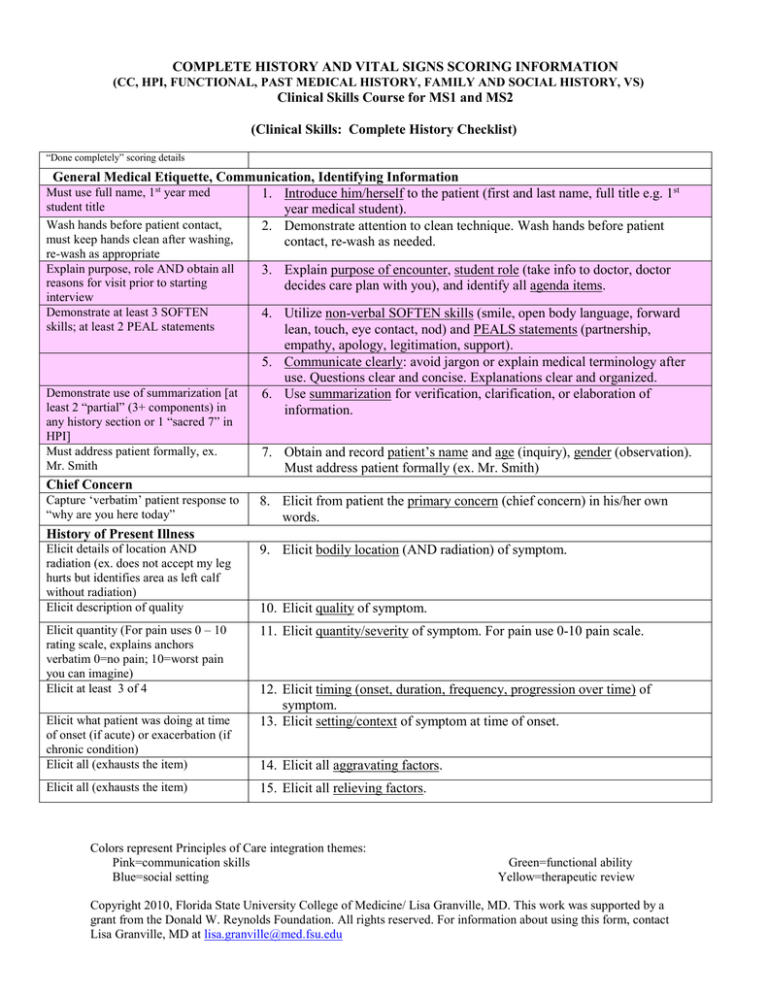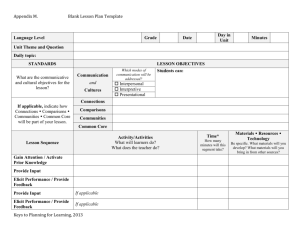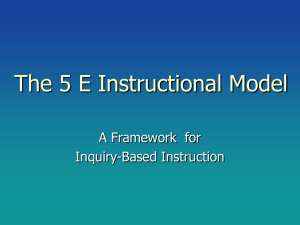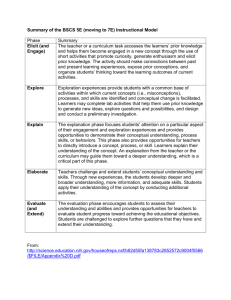
COMPLETE HISTORY AND VITAL SIGNS SCORING INFORMATION
(CC, HPI, FUNCTIONAL, PAST MEDICAL HISTORY, FAMILY AND SOCIAL HISTORY, VS)
Clinical Skills Course for MS1 and MS2
(Clinical Skills: Complete History Checklist)
“Done completely” scoring details
General Medical Etiquette, Communication, Identifying Information
1. Introduce him/herself to the patient (first and last name, full title e.g. 1st
year medical student).
2. Demonstrate attention to clean technique. Wash hands before patient
contact, re-wash as needed.
Must use full name, 1st year med
student title
Wash hands before patient contact,
must keep hands clean after washing,
re-wash as appropriate
Explain purpose, role AND obtain all
reasons for visit prior to starting
interview
Demonstrate at least 3 SOFTEN
skills; at least 2 PEAL statements
Demonstrate use of summarization [at
least 2 “partial” (3+ components) in
any history section or 1 “sacred 7” in
HPI]
Must address patient formally, ex.
Mr. Smith
3. Explain purpose of encounter, student role (take info to doctor, doctor
decides care plan with you), and identify all agenda items.
4. Utilize non-verbal SOFTEN skills (smile, open body language, forward
lean, touch, eye contact, nod) and PEALS statements (partnership,
empathy, apology, legitimation, support).
5. Communicate clearly: avoid jargon or explain medical terminology after
use. Questions clear and concise. Explanations clear and organized.
6. Use summarization for verification, clarification, or elaboration of
information.
7. Obtain and record patient’s name and age (inquiry), gender (observation).
Must address patient formally (ex. Mr. Smith)
Chief Concern
Capture ‘verbatim’ patient response to
“why are you here today”
8. Elicit from patient the primary concern (chief concern) in his/her own
words.
History of Present Illness
Elicit details of location AND
radiation (ex. does not accept my leg
hurts but identifies area as left calf
without radiation)
Elicit description of quality
9. Elicit bodily location (AND radiation) of symptom.
Elicit quantity (For pain uses 0 – 10
rating scale, explains anchors
verbatim 0=no pain; 10=worst pain
you can imagine)
Elicit at least 3 of 4
11. Elicit quantity/severity of symptom. For pain use 0-10 pain scale.
Elicit what patient was doing at time
of onset (if acute) or exacerbation (if
chronic condition)
Elicit all (exhausts the item)
Elicit all (exhausts the item)
10. Elicit quality of symptom.
12. Elicit timing (onset, duration, frequency, progression over time) of
symptom.
13. Elicit setting/context of symptom at time of onset.
14. Elicit all aggravating factors.
15. Elicit all relieving factors.
Colors represent Principles of Care integration themes:
Pink=communication skills
Blue=social setting
Green=functional ability
Yellow=therapeutic review
Copyright 2010, Florida State University College of Medicine/ Lisa Granville, MD. This work was supported by a
grant from the Donald W. Reynolds Foundation. All rights reserved. For information about using this form, contact
Lisa Granville, MD at lisa.granville@med.fsu.edu
Start with general question, then elicit
at least 3 specifics
Elicit previous symptoms: yes or no
16. Elicit associated symptoms and/or pertinent negatives; start with general
question, then 3 specifics.
17. Elicit whether patient has ever had similar symptoms before.
Ex. What do you think is causing this
18. Elicit patient's ideas, hypotheses/theories about cause(s) of
symptoms/condition.
19. Elicit patient's worries/fears about cause(s)/implications of
symptoms/condition.
Ex. What worries you about this, what
fears do you have about this
Impact on at least 1 of 3
20. Elicit impact of symptoms/condition on one or more of the following: daily
functioning, relationships, or self-concept.
Baseline Functional History
Elicit 2 ADLs, 2 IADLs, 2 AADLs
21. Elicit baseline functional ability 2 items in each of 3 areas: 1. ADLs
(bathing, dressing, grooming, mobility noting any aides, continence,
feeding); 2. IADLs (phone use, med use, shopping, cooking, cleaning,
finances, transportation); 3AADLs (recreation, church, school, work)
Past Medical History ( note this section includes current history and health maintenance)
If general response not 1 of 5
22. Elicit information about the patient’s general state of health. Ask general
preferred descriptors, ask patient to
question and then use scale (patient rates health as excellent, very good,
select among 5 descriptors
good, fair, or poor).
Start with general question, then
specifically at least 5 of 9
Elicit all psychiatric conditions
Elicit all drugs used
Elicit at least 4 of 5 details for each
Elicit all OTC AND vitamins or
supplements
Elicit at least 4 of 5 details for each
Elicit all approaches used
Elicit at least 4 of 5 details for each
Elicit all allergies with reaction for
each
Elicit all hospitalizations with date
and indication details for each
Elicit all surgeries with date and
indication details for each
Elicit all accidents/injuries with date
and indication details for each
Elicit all transfusions with indications
and dates for each
Start with general question, then elicit
at least 2 specifics
Elicit all 5 details
23. Elicit information about significant medical diseases/ conditions as an adult.
Specifically elicit information about HTN, heart disease, stroke, lung
disease, DM, cancer, obesity, depression, dementia. Start with general
question, then 5 specifics.
24. Elicit information about all significant psychiatric diseases/ conditions.
25. Elicit information about all current prescription medications including
dosage, frequency, indication, effectiveness, side-effects for each.
26. Elicit information about all non-prescription drugs: over the counter
medications, vitamins, supplements, home/folk remedies including dosage,
frequency, indication, effectiveness, side-effects for each.
27. Elicit information about all non-medication approaches to management of
significant medical diseases/conditions including “dosage”, frequency,
indication, effectiveness, side-effects for each.
28. Elicit information about all previous allergies—particularly allergies to
medication--AND the specific reaction that occurred.
29. Elicit information about all previous hospitalizations, identifying
indications and dates of those hospitalizations (query facility if medical
records desired).
30. Elicit information about all previous surgeries identifying type of
procedures and dates (query facility if medical records desired).
31. Elicit information about all previous accidents/injuries that required medical
care identifying at least 1 detail for each.
32. Elicit information about all previous blood transfusions with indications and
dates.
33. Elicit information about significant childhood illnesses that required
medical attention; start with general question, then 2 specifics.
34. Elicit information from women about menstrual history (age of onset,
Colors represent Principles of Care integration themes:
Pink=communication skills
Blue=social setting
Green=functional ability
Yellow=therapeutic review
Copyright 2010, Florida State University College of Medicine/ Lisa Granville, MD. This work was supported by a
grant from the Donald W. Reynolds Foundation. All rights reserved. For information about using this form, contact
Lisa Granville, MD at lisa.granville@med.fsu.edu
Elicit these 2 items
Do you regularly have checked; how
often; what were the results for at least
3 practices
Elicit 3 of 3 AND Pneumovax if
patient over 65 years or diabetic
current problems, menopause) AND pregnancy (number, outcomes).
35. Elicit (2 items): Over the past 2 weeks have you often been bothered by
feeling down, depressed or hopeless? Over the past 2 weeks, have you often
been bothered by little or no pleasure in doing things?
36. Elicit information (action, frequency and results) about at least 3
preventive/screening practices AND age/gender appropriate-including
blood pressure, cholesterol, vision, dental, height & weight, osteoporosis
risk. If female: Pap smears and mammograms. If over 50 colon cancer
screening with fecal occult blood testing and endoscopy.
37. Elicit information about current immunization status: for adult patient
specifically ask about tetanus, hepatitis B and influenza; for diabetic or
geriatric patient also ask about pneumovax.
Family History
Must ask about 3 generations (parents,
sibs, children) AND spouse: age and
health, not just diseases
Start with general question, then
specifically about at least 5 of 9
38. Elicit information about any blood relatives having illness/ condition with
features similar to patient’s current illness/condition; if YES identify
relationship.
39. Elicit information about the age (now or at time of death) and health status
of immediate family members—parents, siblings, children AND spouse.
40. Elicit information about any diseases that tend to run in his/her family. Start
with general question and then specifically elicit information about at least
5 of the following: HTN, heart disease, stroke, lung disease, DM, cancer,
obesity, depression, dementia.
Personal and Social History
Accept attended college, does not
require degree (masters, doctorate)
Elicit preferred language
Married yes or no
Who lives with
Where lives (house, apt, condo)
Current and former occupations
Hazards or risks
Military yes or no
Elicit all 3: food, shelter, medical care
Current and past use
Quantify: years AND packs per day
Current and past use
Elicit how much AND how long used
Current and past use
Elicit how much AND how long used
Current and past: yes or no
Can not assume yes because of
children
41. Elicit information about the patient's education level. Elicit information
about preferred language.
42. Elicit information about marital status AND living situation (household
members and environment).
43. Elicit information about the patient's current AND former occupations AND
associated hazards/risks. Ask about military service.
44. Elicit information about adequate financial resources for food, shelter, and
medical care.
45. Elicit information about tobacco use—current AND past use—AND
attempt to quantify the amount of use.
46. Elicit information about alcohol use—current AND past use—AND attempt
to quantify the amount of use.
47. Elicit information about recreational drug use—current AND past use—
AND attempt to quantify the amount of use.
48. Elicit information about sexual activity—current and past
[Later this
year you will be required to follow up by identifying: a) gender of sexual
partners; b) sexual activities/practices; and, c) satisfaction with current
sexual activities.]
Colors represent Principles of Care integration themes:
Pink=communication skills
Blue=social setting
Green=functional ability
Yellow=therapeutic review
Copyright 2010, Florida State University College of Medicine/ Lisa Granville, MD. This work was supported by a
grant from the Donald W. Reynolds Foundation. All rights reserved. For information about using this form, contact
Lisa Granville, MD at lisa.granville@med.fsu.edu
What type of diet: quality or quantity,
at least 1 detail
What type of leisure with at least 1
detail
49. Elicit information about usual dietary practices.
50. Elicit information about the patient’s leisure activities/hobbies.
What type of activity with at least 1
detail
Elicit information (yes or no)
51. Elicit information about current physical activity/exercise—AND attempt to
quantify the amount of activity/exercise.
52. Elicit information about whether patient feels safe in relationships; may use
HITS domestic violence query– physically Hurt, Insulted, Threatened with
bodily harm, Screamed at
Do you have: yes or no AND name or
53. Elicit information about the presence of a support system for illness and/or
relation of identified person (ex. my
emotional upset. [Later this year associates support with specific needs/
son)
functional limitation.]
Elicit how spirituality influences
54. Elicit information about how patient's religious beliefs/spirituality influence
health beliefs
health beliefs or practices.
Elicit at least 3 of 5: yes or no
55. Elicit information about at least 3 patient safety practices—including use of
seat belts, smoke detectors, sun screens/sun protection, presence of weapons
in house, weapon safety.
Elicit information on both items
56. Elicit information about advance care planning 2 items: living will AND
health care surrogate
Pulse Rate, Respiratory Rate And Temperature
Check both arms
57. Identify radial pulse in both arms. Using one arm, count number of palpable
Count one arm for 30 seconds
pulses that occur in at least a 30 second interval. Calculate and record the
pulse rate with pattern/quality.
Inconspicuously count for 30 seconds,
58. Inconspicuously measure breathing pattern. Count the number of
record quality
inspirations that occur in at least a 30 second interval. Calculate and record
the respiratory rate with pattern/quality.
59. Measure and record the temperature and record oral, rectal, axillary,
tympanic, or skin measurement.
Blood Pressure
60. Properly position patient (seated). Apply properly-sized blood pressure cuff
to upper arm.
Palpate SBP one arm only
61. Measure systolic blood pressure (SBP) by palpation of radial pulse (as the
cuff is gradually inflated, note the point where the palpable pulse
disappears, inflate 20mmHG above, slowly release and note where pulse
reappears). Deflate cuff completely.
Must use bell
62. Position stethoscope bell just below (not under) cuff, over brachial artery.
Support patient’s relaxed, extended arm at heart level.
63. Inflate cuff to at least 20 mm Hg above palpable SBP. Deflate cuff slowly,
2-3 mm Hg per second.
64. While using the stethoscope, note when sounds are first heard (SBP) and
when sounds muffle or are no longer heard (diastolic blood pressure, DBP).
Be aware of possible auscultatory gap. Record the blood pressure SBP /
DBP.
65. Using patient’s opposite arm, repeat the measurement of SBP and DBP.
Oral Presentation: Ask patient to leave the room and then present findings
Subjective: Chief Concern
Report verbatim sentence(s)
66. Report chief concern, verbatim sentence(s)
Colors represent Principles of Care integration themes:
Pink=communication skills
Blue=social setting
Green=functional ability
Yellow=therapeutic review
Copyright 2010, Florida State University College of Medicine/ Lisa Granville, MD. This work was supported by a
grant from the Donald W. Reynolds Foundation. All rights reserved. For information about using this form, contact
Lisa Granville, MD at lisa.granville@med.fsu.edu
Objective: General Observations, Vital Signs Presentation
Report observation compared to stated
67. Report comparison of the patient’s estimated age (based on observations)
age
with stated age.
State gender
68. Report apparent gender.
Report at least 2 descriptors (ex. well
69. Report body habitus: include physical appearance and body build.
developed, moderately obese,)
State consciousness level
Report at least 1 descriptor
Report at least 1 descriptor
(ex. numerous tattoos related to
motorcycles on arms and legs)
State PR per minute
State RR per minute
State BP for each arm, state position
State Temp degrees, scale, how taken
70. Report level of consciousness (ex. alert, lethargic, stuporous, or comatose).
71. Report demeanor (ex. pleasant, cooperative, irritable, confused, or
combative).
72. Report apparent health status (ex. appears acutely ill, in pain, or in acute
distress (physical or emotional); if the patient has been seen previously,
does the patient appear as he/she usually appears).
73. Report notable characteristics.
74. Report pulse rate per minute with pattern/ quality.
75. Report respiratory rate per minute with pattern/ quality.
76. Report blood pressure for each arm with position.
77. Report temperature with degrees, scale, and how taken.
Colors represent Principles of Care integration themes:
Pink=communication skills
Blue=social setting
Green=functional ability
Yellow=therapeutic review
Copyright 2010, Florida State University College of Medicine/ Lisa Granville, MD. This work was supported by a
grant from the Donald W. Reynolds Foundation. All rights reserved. For information about using this form, contact
Lisa Granville, MD at lisa.granville@med.fsu.edu




